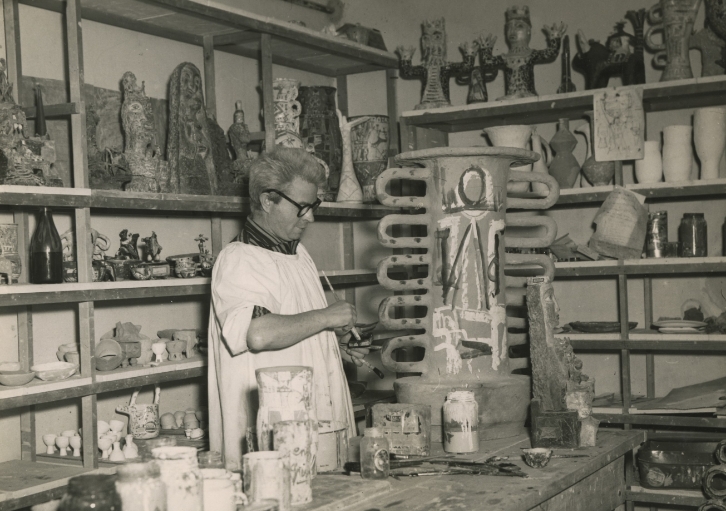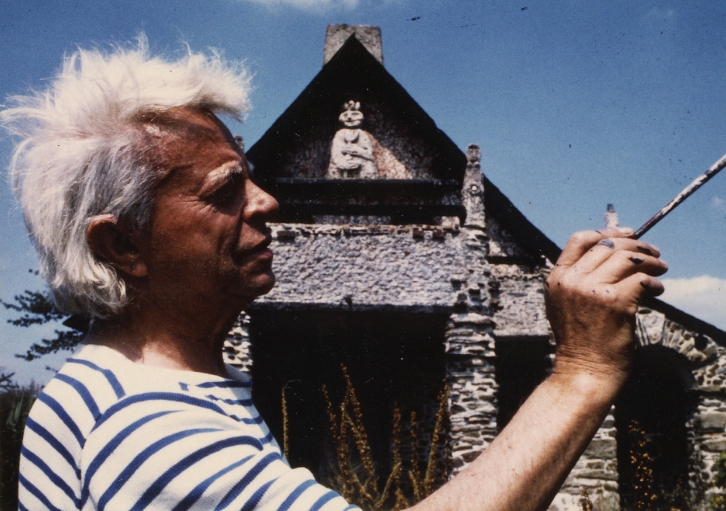The artist

Robert Tatin
UNCLASSIFIABLE ARTIST
Robert Tatin was an artist of many talents: ceramist, painter, lithographer, clothing designer, sculptor, architect… Robert Tatin modeled spaces and materials in an attempt to give form to the world and to answer the great questions that live in it.

INSATIABLE SEEKER
Robert Tatin searched and questioned. His giant statues reach for the sky, his house seems enchanted, his garden in the rural landscape of the Mayenne region opens the field to dreams, reflection and meditation.

ENTHUSIASTIC ABOUT LA MAYENNE
Born in Laval, Robert Tatin traveled the world without ever forgetting his roots in Mayenne.
He spent the last 21 years of his life in his house in Cossé-le-Vivien, around which he built his ‘Strange Museum’ with the help of his wife Lise Tatin.

WHO WAS ROBERT TATIN ?
Throughout his life, Robert Tatin (1902-1983) accumulated experience and knowledge that made him an exceptionally creative artist and builder.
At a very young age he was apprenticed as a decorative painter and then as a carpenter before being adopted by the Compagnons charpentiers du Devoir de Liberté of the city of Tours in 1933. At the head of his construction company in Laval from 1930, he leads a flourishing career and pursues activities of amateur and enlightened artist.
After the Second World War, settled in Paris, he actively participated in the reconstruction of the cultural life of the capital in the company of Jacques Prévert, André Breton and Jean Dubuffet.
In the summer of 1950, he crossed the Atlantic and reached South America, which he explored as far as the southern lands for five years. In Brazil, he continued his research in the field of ceramics with scientists. The first prize at the São Paulo Biennial in 1951 gave him international recognition. It was also in Belo Horizonte during the preparations for the construction of Brasilia that Robert Tatin discovered the flexibility of cement veils. From Brazil to Tierra del Fuego, he frequented both the intellectual and wealthy salons of the large capitals in full development and the popular exuberance of the favelas.
Returning to France in 1955, he settled for a few years on the French Riviera and renewed his ties with the artistic circles of the time.
In 1962, at the age of sixty, he returned permanently to Mayenne, to Cossé-le-Vivien, where he erected the most spectacular of his works. For a little more than twenty years, while pursuing his career as a painter, he modelled around his house a monumental polychrome sculpture in harmony with the landscape that welcomed him.
Often associated with naïve art, surrealism or art brut, Robert Tatin always refused to belong to any one artistic movement and maintained his creative freedom throughout his life, keeping his taste for the artists of the past and their skills but also soaking up the great upheavals of the century that he lived through.
Far from being an isolated artist, he remains unclassifiable and remains, until his last day in 1983, he kept being of the creation of his time, associating a resolutely modern aesthetic to a thought turned towards the future.